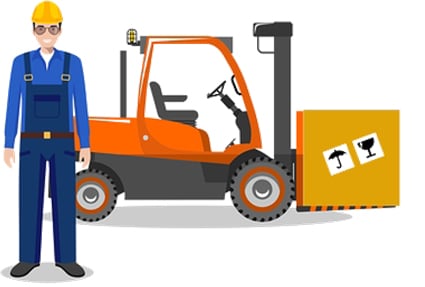Shutdown and Leaving the Operator’s Position
Just as there are specific steps to take prior to operating a forklift, there are additional steps that must be taking when shutting down and leaving the operator’s position.
As with several of the other areas, the specific steps to be taken will depend on the equipment and work environment.
The following are some of the most common areas that should be evaluated relating to shutdown:
Parks in a Designated Area
Your company should have designated forklift parking areas throughout your operation where operators are required to park forklifts when they’re not in use.
Throughout the evaluation, make note of the locations that the operator parks the machine. It would be helpful to have a list of all designated parking areas prior to the evaluation to improve the efficiency of your evaluation.
Lowers the Forks All the Way
Forks should be lowered all the way when parking a piece of equipment. This will help to educe the potential to pedestrians for tripping over the forks. Even they are raised just a few inches from the ground, forks can create a tripping hazard.
Take note of this each time your operator parks the forklift throughout the entire evaluation.
Neutralizes All Controls, De-energizes Equipment, and Turns Off Fuel Source
When parking and leaving the machine, the operator must neutralize all controls, de-energize the forklift, and turn off all fuel sources. For example, if the forklift is powered by propane, the operator must turn off the liquid service valve prior to leaving the machine.
Blocks the Wheels if Parking on an Incline
If your operator is parking on an incline, it’s important to block the wheels of the forklift with proper wheel chalks. Even though the parking brake must be applied, this measure will further significantly reduce the risk of the forklift rolling down the incline.
Engages the Parking Brake
Parking brakes should always be engaged when parking a forklift. Keep an eye on this throughout the evaluation to ensure that the operator is engaging the brake each and every time that the forklift is parked.
The parking brake must be engaged even if the truck is being parked for a short period of time.
Uses 3 Points of Contact to Exit the Operator’s Cab
The operator should use 3 points of contact when exiting the cab, just as when entering.
This will ensure that they are able to maintain their footing and grip when climbing down from the operator’s area and reduce the likelihood of slipping, tripping, or falling.
As with entering the cab, operators will often get into the habit of jumping or “hopping” out of the cab, skipping steps, and increasing the risk of tripping and falling. Keep an eye out for this when your operator is entering and exiting the cab throughout the entire evaluation.


